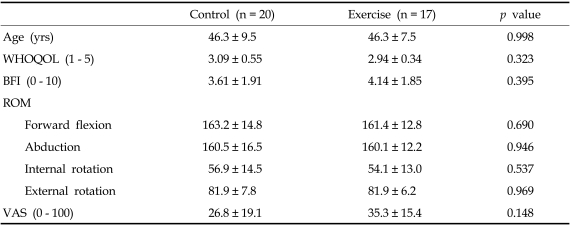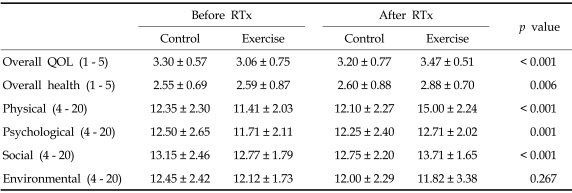Abstract
Purpose
Postoperative radiotherapy for breast cancer has a number of associated complications. This study examined whether supervised moderate-intensity exercise could mitigate the complications that occur during radiotherapy.
Patients and Methods
Forty women were randomized before radiotherapy after various operations for breast cancer. Seventeen patients who were assigned to the exercise group performed supervised moderate-intensity exercise therapy for 50 min 3 times per week for 5 weeks. Twenty-three patients in the control group were asked to perform self-shoulder stretching exercise. The World Health Organization Quality of Life-BREF (WHOQOL-BREF), brief fatigue inventory (BFI), range of motion (ROM) of the shoulder, and pain score were assessed before and after radiotherapy.
Results
There were no significant differences noted at baseline between groups. In the exercise group, there was an increase in the WHOQOL-BREF and shoulder ROM and decrease in BFI and pain score after radiotherapy. On the other hand, patients in the control group showed decrease in the WHOQOL-BREF and shoulder ROM and increase in BFI and pain score after radiotherapy. There were statistically significant differences in the changes in the WHOQOL, BFI, shoulder ROM, and pain score between the groups.
Conclusion
Patients receiving radiotherapy for breast cancer may benefit in physical and psychological aspects from supervised moderate-intensity exercise therapy.
Keywords: Breast cancer, exercise therapy, quality of life, radiotherapy
INTRODUCTION
Breast cancer is the most common type of cancer among women in many Western countries including the United States, and is expected to comprise 31% of all new cases of cancer among women in the US in 2006.1 Breast cancer accounts for 16.8% of the female cancer burden in Korea.2 The incidence of breast cancer has increased but survival has also improved, thus increasingly emphasizing the quality of life (QOL) of women diagnosed with breast cancer.
Among the adjuvant therapies for breast cancer, radiotherapy after mastectomy can reduce the risk of a local recurrence by approximately 2/3 and remains an important component of management for breast cancer.3,4 Although the beneficial effect of postoperative radiotherapy for breast cancer is well documented, there are a number of complications associated with this treatment, that might affect the patients' QOL and possibly survival. Among the long-term irradiation complications, there is cardiac and lung damage, impaired shoulder mobility, and chronic pain.5 Fatigue after radiation therapy for breast cancer is also a common side effect of irradiation and has been reported by 100% of patients.6,7
Previous meta-analysis has shown that there are a number of QOL interventions that may help individuals cope with cancer including cognitive-behavioral therapy, information and educational strategies, individual counseling, psychotherapy, and social support.8 However, a common feature among these interventions is that they do not adequately address the QOL or the physical and functional problems encountered by patients such as fatigue, nausea, and weight gain. Several interventions in the management of radiotherapy-related fatigue have been tested and some randomized studies have recently been published.7,9,10 Although there is no optimal method, some promising results using relaxation therapy, group psychotherapy, sleep, and physical exercise have been reported.
Exercise is associated with improved cardiovascular fitness, pulmonary function, and selfesteem, and with decreased anxiety and depression, which are all aspects of health that are typically diminished in radiotherapy patients.11 Recent studies have reported that exercise is feasible, safe, and well tolerated by breast cancer survivors, and has beneficial effects on QOL, fatigue, fitness, side effects of therapy, body composition, and survival.12-14 Mock et al.15 reported that adherence to a home-based moderate-intensity walking exercise program mitigated the high levels of fatigue that are prevalent during breast cancer treatment.
To our knowledge, there have been few randomized controlled trials to examine the effects of supervised moderate-intensity exercise therapy during radiotherapy for breast cancer. Moreover, most of the studies showed the effects of only 1 type of exercise therapy such as walking exercise to increase aerobic capacity or shoulder stretching exercises to improve shoulder mobility and activities of daily living. Many complications occur simultaneously during radiotherapy for breast cancer; therefore, research on structured exercises and comprehensive evaluations of their effects are needed.
In the present study, we performed a randomized controlled trial to determine whether supervised and structured moderate-intensity exercise during radiotherapy would offer some benefit to breast cancer patients by improving QOL and shoulder mobility and reduce levels of fatigue and pain.
PATIENTS AND METHODS
Patients
Consecutive unselected women on the outpatient waiting list for radiotherapy for breast cancer were approached at their first planned visit. The exclusion criteria included concurrent major health problems that could affect their participation in an exercise program, including uncontrolled hypertension, cardiovascular disease, acute or chronic respiratory disease, and cognitive dysfunction. Forty participants were recruited and randomly assigned to either an exercise or control group. Three patients in the control group were lost during follow up because they did not want to participate in follow-up measurements. Finally, 37 patients completed the follow-up assessment (17 in the exercise group, 20 in the control group). Among patients in the exercise group, 6 had undergone modified radical mastectomy (MRM), 6 had undergone breast-conserving surgery (BCS) with axillary lymph node dissection (ALND), and 5 had undergone BCS with sentinel lymph node biopsy. In the control group, 7 patients had undergone MRM, 6 had undergone BCS with ALND, and 7 had undergone BCS with sentinel lymph node biopsy. Patients were irradiated with a dose of 50 Gy during 5 weeks with a dose per fraction of 2 Gy.
Exercise protocol
Patients assigned to the exercise group attended a supervised exercise program 3 times per week for 5 weeks. The 50-min program consisted of a 10-min warm-up, 30 min of exercise (including stretching exercises focused on the shoulders, aerobic exercise such as treadmill walking and bicycling, and strengthening exercise), and a 10-min cool-down (relaxation period). Heart rates were monitored throughout the class to ensure that patients were exercising at the target heart rate of 50 - 70% of the age-adjusted heart rate maximum.
Patients in the control group were shown how to perform shoulder ROM exercises and were encouraged to continue with normal activities.
Outcome measures
All questionnaires and assessments were assessed at baseline and after completion of radiotherapy.
QOL
The WHOQOL-BREF was developed by the WHOQOL-100.16,17 The Korean version of the WHOQOL was developed in 2002, and has demonstrated valid psychometric properties.18 The WHOQOL-BREF consists of 26 items: 24 items tap 4 subscales/facets, including physical, psychological, social relations, and environmental QOL; 1 item related to overall health; and 1 item that measures overall QOL. Each item is scaled from 1 - 5. The score in each 4 subscale was converted to a 4 - 20 scaled score. The average WHOQOL-BREF score, which was the sum of 26 items of the WHOQOL-BREF divided by 26, was used and ranged from 1 - 5. The higher the score, the more positive response to QOL.
Fatigue
The BFI is a 1-page questionnaire assessing 9 items, each being measured on numeric rating scales from 0 ("no fatigue" or "does not interfere") to 10 ("fatigue as bad as you can imagine" or "completely interferes"), using a single-word designation of the fatigue severity levels and domains to make it easy to administer and understand. The Korean version of the BFI was reported to be a reliable, valid self-rating instrument in its psychometric properties.19 The global score for the BFI was calculated as the mean value of 9 items ranging from 0 - 10. In this study, the BFI was self-reported by all patients at baseline and follow up after the completion of treatment.20
ROM of shoulder
ROM of the shoulder in forward flexion, abduction, and internal rotation and external rotation was checked by the same physical therapist at baseline and follow up after the completion of treatment.
Pain
The severity of pain ("How severe was your pain at the worst moment of the past week?") was scored on a visual analog scale (VAS) ranging from 0 (no pain) to 100 (unbearable pain). All patients were asked to mark the areas of pain on the given body figure.
Statistical analyses
Data were analyzed using SPSS version 10.0 software (SPSS Inc., Chicago, IL, USA). We compared baseline characteristics of the 2 groups using independent-samples t tests. Data were analyzed using analyses of covariance in which groups were compared according to follow-up data with baseline data as the covariate. P value < 0.05 was taken as significant.
RESULTS
Initial assessment
There were no significant differences in all of the outcome measures at the baseline between groups (Table 1). The most common area of pain was the shoulder area of the affected side, followed by the operation site and the arm of the affected side. A few patients complained of pain at the scapular area and lower back.
Table 1.
Comparison of Patients' Characteristics and Baseline Data
WHOQOL, the World Health Organization quality of Life; BFI, brief fatigue inventory; ROM, range of motion; VAS, visual analog scale.
Value represents the mean ± standard deviation.
Follow up
QOL
After radiotherapy, mean WHOQOL score increased in the exercise group and decreased in the control group. There was a significant difference in the change in mean WHOQOL score between groups (Fig. 1). On the WHOQOL-BREF subscale, changes in mean scores in overall health, physical, psychological, and social facets showed significant differences between groups (Table 2).
Fig. 1.
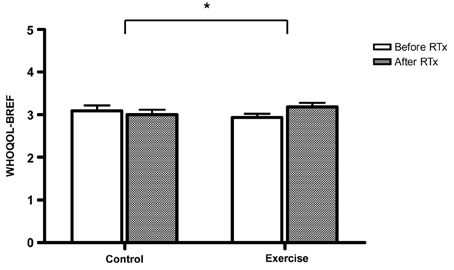
Mean WHOQOL at baseline and after RT in the control and exercise group. *p < 0.05 compared change in mean WHOQOL in the control group and exercise group. RT, radiotherapy.
Table 2.
Mean WHOQOL Subscale at Baseline and After RT in the Control and the Exercise Group
WHOQOL, the World Health Organization quality of life; RT, radiotherapy; QOL, the quality of life.
Value represent the mean ± standard deviation.
Fatigue
The mean BFI decreased in the exercise group and increased in the control group after radiotherapy. There was a significant difference in the change in mean BFI between groups (Fig. 2).
Fig. 2.
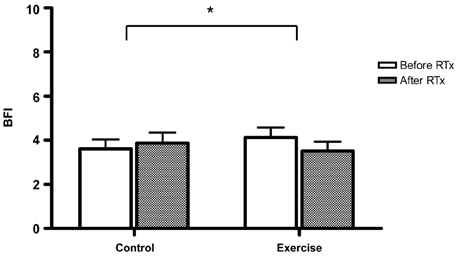
Mean sum BFI at baseline and after RT in the control and exercise group. *p < 0.05 compared change in mean BFI in the control group and exercise group. BFI, brief fatigue inventory; RT, radiotherapy.
ROM of shoulder
After radiotherapy, ROM of the shoulder in all directions increased in the exercise group and decreased in the control group. Changes in ROM of the shoulder in all directions showed significant differences between groups (Fig. 3).
Fig. 3.
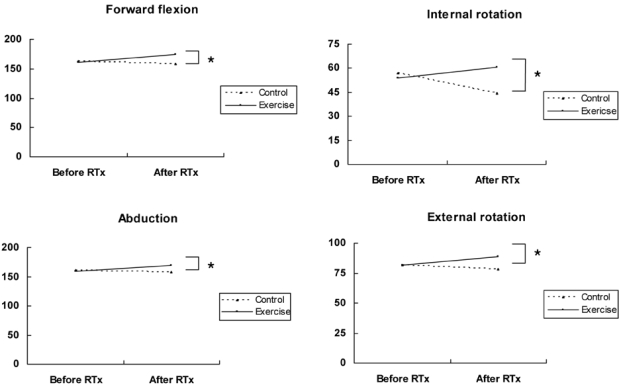
Mean ROM of the shoulder at baseline and after RT in the control and exercise group. *p < 0.05 compared mean shoulder ROM in the control group and exercise group. ROM, range of motion; RT, radiotherapy.
Pain
Mean VAS score decreased in the exercise group and increased in the control group. There was a significant difference in the change in mean VAS score between groups (Fig. 4).
Fig. 4.
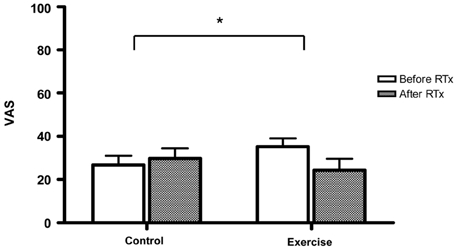
Mean VAS at baseline and after RT in the control and exercise group. *p < 0.05 compared change of mean VAS in the control group and exercise group. VAS, visual analog scale; RT, radiotherapy.
Adverse events
No significant exercise-related adverse events such as lymphedema were reported.
DISCUSSION
Accumulated data have confirmed beneficial effects of radiotherapy on women with breast cancer.3,4 However, there are a number of complications associated with postoperative radiotherapy for breast cancer.5 Among them, shoulder and arm complications are quite troublesome sequelae.21 In addition, life-threatening cardiac and lung damage and radiotherapy-related fatigue can also occur.5,6 All of these complications could decrease QOL. On the other hand, it was reported that exercise during radiotherapy improved QOL.22,23 In this study, QOL of the exercise group showed significant improvement, particularly in the physical and psychosocial areas, compared to the control group. This is in line with previous studies on exercise in patients with breast cancer during adjuvant therapy. One randomized trial demonstrated that women who participated in an exercise program during radiotherapy for early-stage breast cancer showed a trend toward improved physical and psychological functioning.7 Park et al.2 reported that the physical and psychosocial domains showed worsened QOL for patients with breast cancer. Courneya et al.24 showed that exercise training had beneficial effects on physical function and QOL in breast cancer survival, and improvements in physical functioning were associated with improvements in QOL. Therefore, it was suggested that exercise improved physical and psychological functioning during radiotherapy, which was attributed to the improvement of QOL in this study.
In the present study, the exercise group showed a decrease in mean fatigue score after radiotherapy, unlike patients in the control group. Mock et al.15 reported that a home-based moderate-intensity exercise program might effectively mitigate the high levels of fatigue during treatment for breast cancer. Many researchers have reported that exercise therapy for cancer patients during radiotherapy reduced fatigue, but the reason is unclear. Windsor et al.25 suggested that improvement in physical functioning by exercise therapy might help overcome radiation fatigue. In patients with cancer who were rendered disease-free after completing radiotherapy 9 mo earlier, the most significant predictor of fatigue was the degree of post-radiotherapy functional disability.26 Advising patients to rest and reduce levels of activity leads to muscular deconditioning and a loss of performance, which means that more effort is needed for patients to perform normal daily activities. Moreover, Schwartz suggested that the effects of exercise on QOL might be mediated by the effects of exercise on fatigue.22
There was no significant difference in baseline ROM of the shoulder joint and baseline level of pain between the 2 groups. After radiotherapy, the control group showed decreased ROM of the shoulder in all directions and increased pain score. In contrast, the exercise group showed increased ROM of the shoulder in all directions and decreased pain score. Most patients complained of mild to moderate pain at the shoulder girdle and/or incision area. Pain and muscle spasms can occur in the shoulder region as a result of muscle guarding.27 In addition, chest wall adhesion can lead to increased risk of pain and reduction in ROM of the shoulder on the involved side as well as postural dysfunction.28 Robb et al.29 reported a positive outcome in a pain management program that included exercise for patients with chronic cancer treatment-related pain. Andersen et al.30 also reported that a 6-week exercise intervention decreased the level of pain and the other treatment-related symptoms in cancer patients during chemotherapy. Baseline pain score of patients included in this study was low, indicating little room for reduction in pain. Nevertheless, we could show significantly different changes in pain scores between the 2 groups. So it seemed not to come into question.
In most studies examining the effects of exercise, only the effects of walking exercise on aerobic capacity or the effects of shoulder stretching exercises on improvement of shoulder mobility were evaluated.21,23,31,32 Although it could improve a single parameter in such cases, it did not alter the other parameters for exercises that had not been performed. Therefore, it was difficult to improve overall physical state. It is believed that a structured exercise program including various exercises would produce better results. Segal et al.33 reported greater improvement in physical functioning of participants in the self-directed exercise group than the supervised exercise group. However, the duration of exercise was so long (26 weeks) that there was a lower dropout rate in the more convenient self-directed home-based exercise group than the supervised class, which was attributed to significant differences in increased physical functioning. Pickett et al.32 reported that 22% of patients did not exercise, and 13% of patients dropped out when moderate-intensity walking exercise was performed for 6 mo. In contrast, Windsor et al.25 reported that adherence increased when the same moderate-intensity exercise was performed for 4 weeks. Indeed, Mutrie et al.34 reported that the supervised exercise group showed improvement in physical and psychological functioning in comparison with the home-based exercise group, which was similar to our results. Therefore, supervised exercise guided by professional therapists might be more effective than home-based exercise, if it is possible to achieve high adherence. In this study, the exercise program was initiated the same day that patients received radiotherapy; therefore there was no dropout in the exercise group. However there was a 13% dropout rate in the control group.
This study had a small sample size, and patients were assessed immediately after radiotherapy. Therefore, further research with long-term follow up studies and larger sample size is needed.
In conclusion, despite the small sample size, there were positive physical and psychological benefits from supervised moderate-intensity exercise during radiotherapy for breast cancer. There was no evidence of any negative effects associated with exercise in cancer survivors. Cancer care teams should consider exercise as a part of rehabilitation during radiotherapy.
References
- 1.Jemal A, Siegel R, Ward E, Murray T, Xu J, Smigal C, et al. Cancer statistics, 2006. CA Cancer J Clin. 2006;56:106–130. doi: 10.3322/canjclin.56.2.106. [DOI] [PubMed] [Google Scholar]
- 2.Park EJ, Jeon YW, Han SI, Oh SJ. A preliminary study on the quality of life for patients who had breast cancer operations. J Korean Breast Cancer Soc. 2004;7:299–305. [Google Scholar]
- 3.Effects of radiotherapy and surgery in early breast cancer. An overview of the randomized trials. Early Breast Cancer Trialists' Collaborative Group. N Engl J Med. 1995;333:1444–1455. doi: 10.1056/NEJM199511303332202. [DOI] [PubMed] [Google Scholar]
- 4.Favourable and unfavourable effects on long-term survival of radiotherapy for early breast cancer: an overview of the randomised trials. Early Breast Cancer Trialists' Collaborative Group. Lancet. 2000;355:1757–1770. [PubMed] [Google Scholar]
- 5.Senkus-Konefka E, Jassem J. Complications of breast-cancer radiotherapy. Clin Oncol (R Coll Radiol) 2006;18:229–235. doi: 10.1016/j.clon.2005.11.004. [DOI] [PubMed] [Google Scholar]
- 6.Jereczek-Fossa BA, Marsiglia HR, Orecchia R. Radiotherapy-related fatigue. Crit Rev Oncol Hematol. 2002;41:317–325. doi: 10.1016/s1040-8428(01)00143-3. [DOI] [PubMed] [Google Scholar]
- 7.Mock V, Dow KH, Meares CJ, Grimm PM, Dienemann JA, Haisfield-Wolfe ME, et al. Effects of exercise on fatigue, physical functioning, and emotional distress during radiation therapy for breast cancer. Oncol Nurs Forum. 1997;24:991–1000. [PubMed] [Google Scholar]
- 8.Meyer TJ, Mark MM. Effects of psychosocial interventions with adult cancer patients: a meta-analysis of randomized experiments. Health Psychol. 1995;14:101–108. doi: 10.1037//0278-6133.14.2.101. [DOI] [PubMed] [Google Scholar]
- 9.Decker TW, Cline-Elsen J, Gallagher M. Relaxation therapy as an adjunct in radiation oncology. J Clin Psychol. 1992;48:388–393. doi: 10.1002/1097-4679(199205)48:3<388::aid-jclp2270480318>3.0.co;2-o. [DOI] [PubMed] [Google Scholar]
- 10.Forester B, Kornfeld DS, Fleiss JL, Thompson S. Group psychotherapy during radiotherapy: effects on emotional and physical distress. Am J Psychiatry. 1993;150:1700–1706. doi: 10.1176/ajp.150.11.1700. [DOI] [PubMed] [Google Scholar]
- 11.Delisa JA, Gans BM, Walsh NE, Bockenek WL, Frontera WR, Geiringer SR, et al. Physical medicine and rehabilitation: principles and practice. 4th ed. Philadelphia: Lippincott Williams & Wilkins; 2005. pp. 402–405. [Google Scholar]
- 12.Campbell A, Mutrie N, White F, McGuire F, Kearney N. A pilot study of a supervised group exercise programme as a rehabilitation treatment for women with breast cancer receiving adjuvant treatment. Eur J Oncol Nurs. 2005;9:56–63. doi: 10.1016/j.ejon.2004.03.007. [DOI] [PubMed] [Google Scholar]
- 13.Holmes MD, Chen WY, Feskanich D, Kroenke CH, Colditz GA. Physical activity and survival after breast cancer diagnosis. JAMA. 2005;293:2479–2486. doi: 10.1001/jama.293.20.2479. [DOI] [PubMed] [Google Scholar]
- 14.McNeely ML, Campbell KL, Rowe BH, Klassen TP, Mackey JR, Courneya KS. Effects of exercise on breast cancer patients and survivors: a systematic review and meta-analysis. CMAJ. 2006;175:34–41. doi: 10.1503/cmaj.051073. [DOI] [PMC free article] [PubMed] [Google Scholar]
- 15.Mock V, Frangakis C, Davidson NE, Ropka ME, Pickett M, Poniatowski B, et al. Exercise manages fatigue during breast cancer treatment: a randomized controlled trial. Psychooncology. 2005;14:464–477. doi: 10.1002/pon.863. [DOI] [PubMed] [Google Scholar]
- 16.The World Health Organization Quality of Life assessment (WHOQOL): position paper from the World Health Organization. Soc Sci Med. 1995;41:1403–1409. doi: 10.1016/0277-9536(95)00112-k. [DOI] [PubMed] [Google Scholar]
- 17.Development of the World Health Organization WHOQOL-BREF quality of life assessment. The WHOQOL Group. Psychol Med. 1998;28:551–558. doi: 10.1017/s0033291798006667. [DOI] [PubMed] [Google Scholar]
- 18.Min SK, KIM KI, Park IH. Korean version of WHOQOL. Seoul: Hana; 2002. pp. 47–65. [Google Scholar]
- 19.Yun YH, Wang XS, Lee JS, Roh JW, Lee CG, Lee WS, et al. Validation study of the korean version of the brief fatigue inventory. J Pain Symptom Manage. 2005;29:165–172. doi: 10.1016/j.jpainsymman.2004.04.013. [DOI] [PubMed] [Google Scholar]
- 20.Mendoza TR, Wang XS, Cleeland CS, Morrissey M, Johnson BA, Wendt JK, et al. The rapid assessment of fatigue severity in cancer patients: use of the Brief Fatigue Inventory. Cancer. 1999;85:1186–1196. doi: 10.1002/(sici)1097-0142(19990301)85:5<1186::aid-cncr24>3.0.co;2-n. [DOI] [PubMed] [Google Scholar]
- 21.Bentzen SM, Dische S. Morbidity related to axillary irradiation in the treatment of breast cancer. Acta Oncol. 2000;39:337–347. doi: 10.1080/028418600750013113. [DOI] [PubMed] [Google Scholar]
- 22.Schwartz AL. Fatigue mediates the effects of exercise on quality of life. Qual Life Res. 1999;8:529–538. doi: 10.1023/a:1008978611274. [DOI] [PubMed] [Google Scholar]
- 23.Mock V, Pickett M, Ropka ME, Muscari Lin E, Stewart KJ, Rhodes VA, et al. Fatigue and quality of life outcomes of exercise during cancer treatment. Cancer Pract. 2001;9:119–127. doi: 10.1046/j.1523-5394.2001.009003119.x. [DOI] [PubMed] [Google Scholar]
- 24.Courneya KS, Mackey JR, Bell GJ, Jones LW, Field CJ, Fairey AS. Randomized controlled trial of exercise training in postmenopausal breast cancer survivors: cardiopulmonary and quality of life outcomes. J Clin Oncol. 2003;21:1660–1668. doi: 10.1200/JCO.2003.04.093. [DOI] [PubMed] [Google Scholar]
- 25.Windsor PM, Nicol KF, Potter J. A randomized, controlled trial of aerobic exercise for treatment-related fatigue in men receiving radical external beam radiotherapy for localized prostate carcinoma. Cancer. 2004;101:550–557. doi: 10.1002/cncr.20378. [DOI] [PubMed] [Google Scholar]
- 26.Smets EM, Visser MR, Willems-Groot AF, Garssen B, Schuster-Uitterhoeve AL, de Haes JC. Fatigue and radiotherapy: (B) experience in patients 9 months following treatment. Br J Cancer. 1998;78:907–912. doi: 10.1038/bjc.1998.600. [DOI] [PMC free article] [PubMed] [Google Scholar]
- 27.Kisner C, Colbby LA. Therapeutic exercise: foundations and techniques. 5th ed. Philadelphia: Davis Company; 2007. pp. 838–842. [Google Scholar]
- 28.Beeby J, Broeg PE., 2nd Treatment of patients with radical mastectomies. Phys Ther. 1970;50:40–43. doi: 10.1093/ptj/50.1.40. [DOI] [PubMed] [Google Scholar]
- 29.Robb KA, Williams JE, Duvivier V, Newham DJ. A pain management program for chronic cancer-treatment-related pain: a preliminary study. J Pain. 2006;7:82–90. doi: 10.1016/j.jpain.2005.08.007. [DOI] [PubMed] [Google Scholar]
- 30.Andersen C, Adamsen L, Moeller T, Midtgaard J, Quist M, Tveteraas A, et al. The effect of a multidimensional exercise programme on symptoms and side-effects in cancer patients undergoing chemotherapy--the use of semi-structured diaries. Eur J Oncol Nurs. 2006;10:247–262. doi: 10.1016/j.ejon.2005.12.007. [DOI] [PubMed] [Google Scholar]
- 31.Johansen J, Overgaard J, Blichert-Toft M, Overgaard M. Treatment of morbidity associated with the management of the axilla in breast-conserving therapy. Acta Oncol. 2000;39:349–354. doi: 10.1080/028418600750013122. [DOI] [PubMed] [Google Scholar]
- 32.Pickett M, Mock V, Ropka ME, Cameron L, Coleman M, Podewils L. Adherence to moderate-intensity exercise during breast cancer therapy. Cancer Pract. 2002;10:284–292. doi: 10.1046/j.1523-5394.2002.106006.x. [DOI] [PubMed] [Google Scholar]
- 33.Segal R, Evans W, Johnson D, Smith J, Colletta S, Gayton J, et al. Structured exercise improves physical functioning in women with stages I and II breast cancer: results of a randomized controlled trial. J Clin Oncol. 2001;19:657–665. doi: 10.1200/JCO.2001.19.3.657. [DOI] [PubMed] [Google Scholar]
- 34.Mutrie N, Campbell AM, Whyte F, McConnachie A, Emslie C, Lee L, et al. Benefits of supervised group exercise programme for women being treated for early stage breast cancer: pragmatic randomised controlled trial. BMJ. 2007;334:517. doi: 10.1136/bmj.39094.648553.AE. [DOI] [PMC free article] [PubMed] [Google Scholar]



